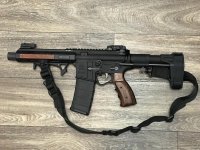My experience is with the Fostech Echo. It was purchsed after researhing the Echo and the Franklin BFS.
Got one of the first runs made, and later upgraded it to an Echo II. No, it DOES NOT require a special bolt carrier to function. (The original Echo did, and the modified bolt carriers were suppled by Fostech with the purchase of the trigger at no extra charge. With current production a regular AR or M16 bolt carrier works. This is the reason for the Echo II).
The Franklin BFS binary can be outrun by someone with a fast trigger finger, causing the hammer to follow the bolt home and leaving an unfired round in the chamber. This stops the music until the operating rod handle is functioned to eject the unfired round and re-cock the hammer. How fast the rifle functions is purely a function of the operator's trigger finger. In that respect there is no difference in speed that I can determine between the Echo and the BFS.
Given the BFS getting outrun by a fast trigger finger, as can be seen in several on-line videos, I went with the Fostech unit. Also, many BFS users have seen a need to tune the trigger (balance some of the springs) where the Fostech unit runs pretty well right from intial installation. Again, a fast trigger finger cannot outrun the Echo.
In fairness I would presume that Franklin Armory has worked to improve their unit over the past few years since I bought my Echo, perhaps eliminating some of the issues mentioned, but I have not kept up with their product since going with the Fostech product. Perform due diligence. There are many product comparissons on line.
My Echo runs well with 5.56, .300 BLK, 9x19mm uppers and (surprisingly) .22LR.
When one decides to try .22 rimfire in a dedicated upper, the situation reverses somewhat, with the BFS probably superior to the Echo. Where the Echo can be problematical, the BFS has a reputation for pretty easy .22 rimfire function. That said, I was lucky with my Echo unit, and after making a simple modification to the CMMG full-auto sear trip that is needed (no it does not make the gun full auto, just makes the binary function operate) my rifle works well (or at least as well as any .22 rimfire with an occasional faulty dud round functions). Lots of fun, and cheap! A Lightnin' Loader fron McFadden Machine allows one to load a 27-32 round Black Dog magazine in about 10 seconds, helping to spend more money faster.
There was an aftermarket spring that greatly improved the original Echo's trigger pull that is probably still available. Quite nice actually, with no change in reliability. The current generation Echos are pretty good as they come.
Every time I have taken this to the range for friends or family to try, flipping the selector to binary produces facial expressions that suggest they have just done something really naughty, and got away with it. It's a giggle switch. The only reservations people have is that ammo gets expensive. Hence the attraction of shooting .22 rimfire.
Is it dangerous to use a binary trigger? No more (or less) dangerous than intentionally firing any other double tap. If for some weird reason the second round must be canceled, simply continue to hold the trigger back and put the rifle on safe or semi, and release the trigger. When one decides to resume shooting, flip to semi or binary and continue as desired. It's a well thought out system.
What is the utility of these triggers? Do you need one? As mentioned above they produce a quick double tap. However, at between $400-$500 for a binary trigger, you can instead buy a truly superior AR15 trigger for half that amount and spend the balance on ammuntion to perfect your double tap.
About a third of my military career was spent in special ops (where personally I did absolutely nothing noteworthy). I did however work closely with some people from whom I learned stuff. One thing they taught me was that they almost never use full auto from a shoulder-fired weapon. The occasions where they do use it usually involve an ambush where they want to produce the maximum fear and confusion in an enemy, usually while trying to break contact from a pursuit. Hardly something that the typical defensive carbine user or 3-gun competitor would need.
So to the extent that a binary trigger simulates full-auto, consider it primarily a range toy that helps turn money into noise. Without the hassle of a tax stamp.
Oh, and they are a celebration of American ingenuity.



